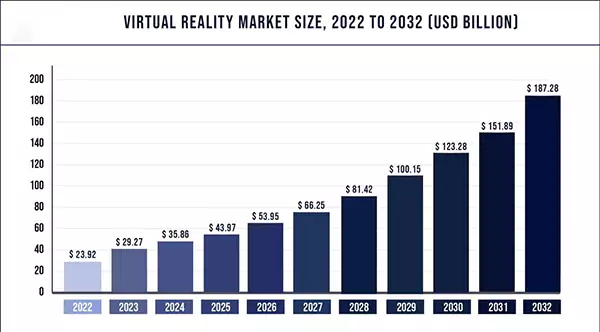
Virtual reality has completely changed the way we look at or utilize digital platforms now. Similarly, blockchain technology revolutionized traditional systems by creating a safer and more transparent environment. Merging these two technologies can have a great impact on several fields.
While VR is exposed to several risks to privacy and security, blockchain mechanism has the potential to solve and even introduce an improved concept of interoperability.
Therefore, in this piece of information, we’ll explain 7 use cases of blockchain technology in virtual reality. This integration can have a bright future, providing immersive experiences to users in many fields.
By utilizing decentralized marketplaces, students have access to secure and interactive course materials. The blockchain also proposes a tamper-proof way to archive academic achievements and transcripts, which would make it easier for academic institutions to store and employers to review.
Its linked databases store the information in a standardized format, ensuring uniformity and easy sharing. It ensures the security of virtual reality-based exhibits, preserving the scarcity and originality of artificial intelligence software as well.
It helps establish item ownership and verifies the authenticity of virtual objects, allowing guarded and collaborative sharing of information and data. Virtual reality can make hard-to-grasp concepts clearer, and children retain information better through interactive media.
With blockchain, AI experiences become universally accessible, providing a highly efficient and reliable way to learn.
Companies that focus on producing VR products and pieces of software rely on advertising for revenue and to popularize the concept of VR in the mainstream. In this case, the blockchain can track the effectiveness of ad campaigns. It also allows users to interact with advertisements and be compensated with its linked coins.
The smart contracts used in it would ensure that ads in virtual environments are being promoted to the proper target audience. And even record the way users react to a specific ad. There have been quite a few examples of worldwide renowned companies integrating AI tech as part of their marketing practices.
For instance, McDonald’s has introduced The Happy Goggles, similar to Google Cardboard, to make VR more accessible for children visiting fast-food restaurants. Ikea Place is another great example of a company using VR-based apps to improve its services. It allowed customers to view how a specific furniture piece would suit their home and thus make an informed decision about whether to purchase it.
With the help of the blockchain, both of these ventures would become safe and sustainable. Especially, when it comes to the second example – no personal details or captures of the personal space would be easily tampered with. Virtual commerce further enriches the shopping experience by providing customers with an exact idea of products.
The combination of both creates a secure virtual marketplace and safeguards against fraudulent transactions. Blockchain ensures copyrights and authenticity of digital creations, which is paramount to any content creator as well.
Actually, as the experts from VR Today Magazine claim, more and more companies are using virtual reality to connect with their audience in a new and innovative way.
As most VR apps must be purchased before user exploitation and those that are free tend to be offering in-app purchases, one must be careful when buying anything online. By verifying and tracking ownership of virtual assets, blockchain helps prevent fraud in transactions.
It also enhances security in computerized transactions, ensuring the safety and integrity of virtual asset ownership. Smart contracts on blockchain can automate operations and eliminate the need for intermediaries, further increasing the security of virtual reality transactions.
By offering a shielded, transparent system for asset ownership, it prevents theft and hacking of virtual assets. The greatest perk of its decentralized nature is that it enhances trust between buyers and sellers in virtual reality transactions.

(This graph shows the virtual reality market size, from 2022 to 2032, US$ billion).
Major studios, such as Disney, are exploring the use of it to manage AI content creation. This application helps track the origin and usage rights of 3D assets, preventing piracy and unauthorized use, while verifying the integrity of assets as well. It also streamlines the real-time management of asset inventory, making content production highly efficient.
As a result, VR supply chains become more reliable, cost-effective, and trustworthy, benefiting both creators and consumers. It likewise ensures secure collaborations with artists and transparent royalty payments. The blockchain technology has a huge potential to improve the modern payment systems.
If you are looking for guides related to crypto payments, make sure to check Coinlabz – they have great content related to blockchain use cases, crypto transactions, and more.
Enabling cross-platform access to VR content is possible with the blockchain’s interoperability features. That makes it highly convenient for users to find everything they need and easily interact with each other.
The blockchain can be used to verify sponsorship and traffic in virtual reality advertising. This enables metrics, tracking, and analytics for ads, ensuring trust and transparency in partnerships between brands and consumers.
It also offers a secure way to track the effectiveness of campaigns and to reward customers for interacting with ads. Eye movements can be tracked to measure ad attention, providing a highly accurate picture of consumer engagement. All the collected data regarding the customer’s behavior is beneficial for creating more productive marketing strategies in the VR field.
Its linked coins can be used to incentivize customers to interact with advertisements as well. This form of consumer motivation can eventually lead to a further increase in sales.
Blockchain mechanism is an indispensable part of providing proper user verification. As many VR apps obtain personal details, it can be hard to sustain a safe and hacker-free platform.
With the help of the blockchain, it will become immensely easy for providers to protect the identities of users and manage their authentication.
Do You Know?
According to Global Newswire, the global blockchain in manufacturing market size increased from $49.50 million in 2021 to $85.64 billion in 2023. That is a 73% CAGR.
Blockchain technology has the potential to transform the way we interact with VR content and propose new ways institutions, marketplaces, and commercial brands operate in case of in-house effectiveness and customer satisfaction.
With secure and efficient transactions, enhanced security, and access to content, this technology provides a unique platform for users to take advantage of the benefits of virtual reality.
No matter if you’re looking for an immersive gaming experience, a unique educational opportunity, or a safe platform to conduct transactions, this technology is the perfect way to make the most of your augmented experience.
